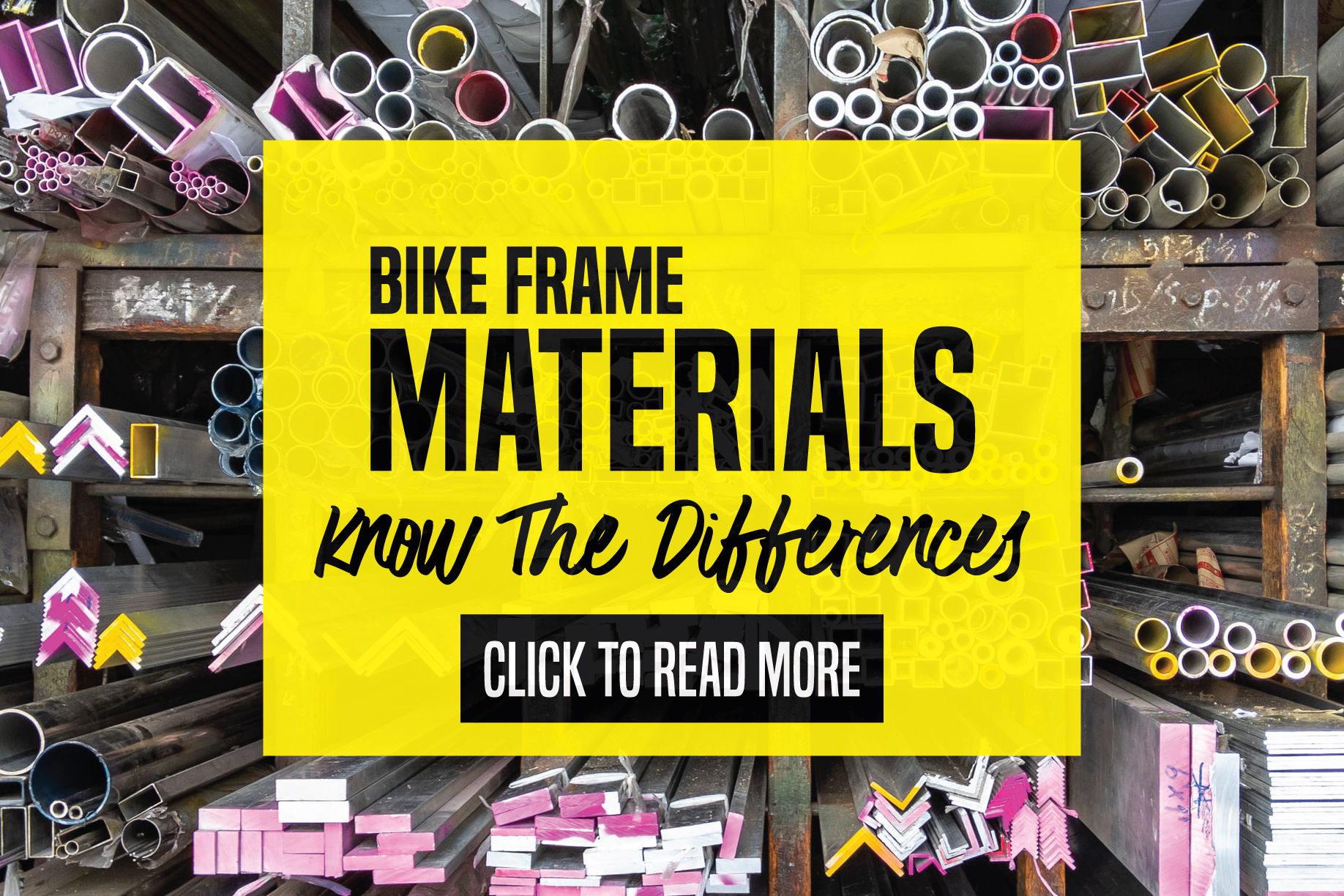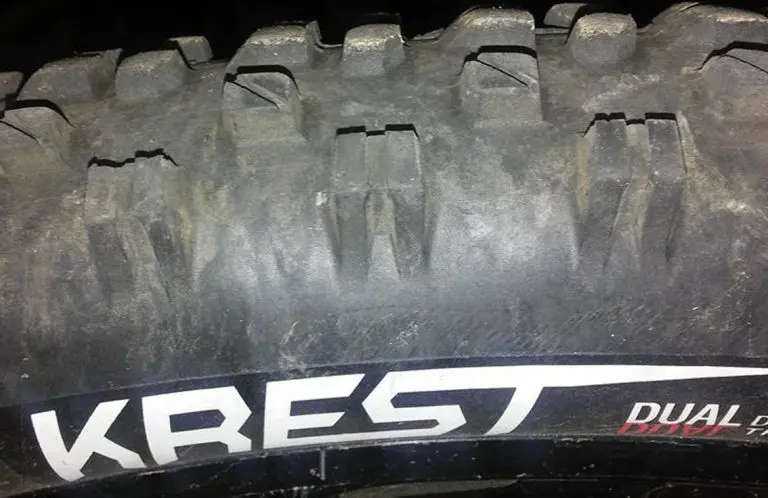Bike Frame Materials: Know The Differences
4 Most Common Frame Materials Used Today
- Steel
- Aluminum
- Titanium
- Carbon Fiber
Steel
- PROS: Very Strong, Durable, Excellent Ride Quality (Inherently Absorbs Shock), Highly Resistant To Metal Fatigue, Easily Repairable, Recyclable, Typically Affordable However Is Often More Expensive To Mass Manufacture Than Aluminum (Depending On Type – Mild/Carbon Steel vs Stainless)
- CONS: Heavy, Can Rust and Corrode
Historically the universal go-to material choice in bike frame building for over a hundred years. Steel is relatively inexpensive and offers high strength, long term durability, and can be repaired with relative ease. The ride quality of steel — despite the rigidity that comes to mind — actually intrinsically exhibits properties of what is referred to as Elastic Modulus, which describes why steel can better absorb shock and provide a smoother ride than metals with lower elasticity ratings — in layman’s terms, steel can (safely) flex and this helps absorb vibration and bumps. However, as most people are aware steel is very heavy, plus it can rust and corrode if not properly cared for.
Fun Fact: Although quite heavy a growing niche of cyclists prefer the ride characteristics, simplicity, and solid reliability of a durable fully rigid steel framed bike on plus sized tires, often seen in all-terrain bikepacking rigs. The combination of aired-down large volume tires and steel frame make for a surprisingly smooth ride.
Aluminum
- PROS: High Strength To Weight Ratio, Lightweight (2 1/2 To 3 Times Less Dense Than Steel), Won’t Rust and Corrosion Resistant, Fast Responsive Handling, Highly Recyclable
- CONS: Generally More Costly Than Steel (Though Still Less Than Stainless), Subjective But Ride Quality Can Be Perceived As Stiffer and More Harsh (Depending On Alloy and Frame Building Techniques Used), Fatigues More Quickly (Shorter Frame Life Span), Trickier To Repair
While significantly lighter than steel, aluminum is a dependable lightweight metal option with benefits that also include strength, corrosion resistance and being rust proof. For the most part gone are the traditional days of stiff harsh-riding aluminum frames, modern frame building techniques such as hydro-forming has given frame designers and engineers a competitive edge and ability to fine tune designs and produce bends and shapes with varying wall thickness within the same piece of metal, this results in a significantly improved ride that exhibits higher performing characteristics of controlled frame compliance and rigidity in key frame areas producing optimum comfort and maximum power transfer.
Fun Fact: Depending on material grade some high-end aluminum frames beat out low grade carbon bikes in both lightness and strength.
Titanium (Ti)
- PROS: Highest Strength To Weight Ratio of All Metals, Lightweight (Nearly 1/2 As Dense As Steel While Sharing Many of The Same Qualities of Strength and Compliance), Extremely Rust Proof and Corrosion Resistant, Long Lasting, Doesn’t Need To Be Painted (Even More Weight Savings)
- CONS: Very Expensive, Specialized and Difficult To Manufacture (Fewer Frame Manufacturers Means Limited Or Custom-Only Frame Options), Difficult To Repair
What makes titanium such a wonder metal is its combination of steel-like strength and lightness like aluminum. Basically a more ideal version of steel, titanium exhibits similar inherent ride qualities like natural elasticity and vibration damping while weighing only half as much, oh AND it won’t rust or corrode. Being both light and strong means a frame can be made using significantly less material, this is where the major benefit of titanium’s superior strength-to-weight ratio is found. For example, aluminum, which is actually significantly less dense than titanium requires a significantly thicker frame wall than would be required of titanium to provide matching strength. Having to spec a thicker frame offsets the weight advantage aluminum would normally have versus a titanium frame of the same design.
Fun Fact: The strength to weight ratio and natural anti-corrosive properties of titanium make it an ideal material for use in harsh environments — aircraft, naval ships, spacecraft, armor plating, missiles, ship propellers, oceanic equipment components, submarines, radioactive nuclear waste storage, surgical implants and medical instruments — just to name a few.
Carbon Fiber (Carbon Fiber Reinforced Polymer)
- PROS: Very Lightweight, Incredible Strength To Weight Ratio (Up To 5 Times Stronger Than Steel and Twice As Stiff), Stiff Yet Compliant Ride Characteristics, Highly Customizable Frame Shapes and Vast Design Potential, Highly Resistant To Fatigue, Tolerant To High Temperatures, High Chemical Resistance, Low Thermal Expansion
- CONS: Very Expensive (Although Lower Grades Can Cost Less Than High Quality Aluminum), Hands-On Labor Intensive Manufacturing Processes, Significantly Longer Production Times, Not Very Environmentally Friendly To Produce (14 Times As Energy Intensive As Producing Steel), Reuse and Recycling Tech Still In Early Developing Stages, Damage Can Create Material Fractures (Crashes, Over Tightening of Bolts, Debris Impacts, etc.) That Eventually Leads To Sudden Abrupt Catastrophic Failure (Shattering), Repairs Are Possible But Can Be Difficult
Despite the futuristic sounding name carbon fiber has actually been around since 1958, which in the realm of materials means it’s still a material in its infancy, especially considering that comparatively steel has been around since the Roman Age, or about 4,000 years. Invented near Cleveland, Ohio — it wasn’t until 1963 when a British research center developed a new manufacturing process that was able to bring the strength potential of the material to fruition. Carbon fiber is manufactured, not naturally occurring. The individual fibers in carbon fiber are extremely thin ranging from 0.005 to 0.010 millimeters in diameter (a human hair is about 0.10 mm). Thousands of these fibers are twisted together to form a yarn and this yarn is then woven to create that more familiar checkered pattern fabric we call, “carbon fiber.” It’s this fabric that is then combined in a part mechanical and part chemical process using special epoxy resins or polymers to form hardened parts — technically called, carbon fiber reinforced polymer.
Fun Fact: Counterfeit carbon fiber products exist! While many of these faked products have the appearance of genuine carbon fiber and look nice they lack the true strength and performance characteristics of the real deal, this can be dangerous plus these companies that sell and produce it likely won’t help you out in any way in the event of part failures. Be weary of inexpensive carbon fiber bike components that are priced significantly less than reputable brand’s products, if the price is too good to be true this is usually a good indicator of a lesser product trying to pass as the real thing.
Bike Frame Materials Explained, Bike Exchange, (Published By) The BikeExchange Team, August 16, 2017
https://www.bikeexchange.com/blog/bike-frame-materials-explained
“Carbon Fibers”, (Page Last Updated: June 06, 2020), Wikipedia, Available At: https://en.wikipedia.org/wiki/Carbon_fibers (Accessed: June 18, 2020)
Carbon Fiber Facts, Carbon Fiber Designs, (Published By) Shelby, (Date N/A)
https://www.carbonfiberdesigns.com/carbon-fiber-facts.html
Clash of The Titans: Aluminum VS. Titanium, Mobility Management, (Published By) Laurie Watanabe, March 1, 2010
https://mobilitymgmt.com/Articles/2010/03/01/Aluminum-vs-Titanium.aspx?Page=1
Corrosion vs Rust, Heavy Industries THeming Corp, (Published By) Casey Hughes, (Date N/A)
https://heavyindustries.ca/corrosion-vs-rust/
The Differences Between Bike Frame Materials–Explained, Bicycling, (Published By) Hearst Digital Media, Jason Sumner, June 27, 2018
https://www.bicycling.com/bikes-gear/a21784287/bike-frame-materials-explained/
Frame Material: Carbon VS. Aluminum, The Pros Closet, (Published By) Bruce Lin, (Date N/A)
https://www.theproscloset.com/blogs/news/frame-material-carbon-vs-aluminum
Full List of Rigid Steel Off-Road Touring Bikes (With Plus Tires), Bike Packing, (Published By) Cass Gilbert, January 31, 2019
https://bikepacking.com/index/rigid-steel-off-road-touring-bikes/
Is Carbon Fiber Better For The Environment Than Steel? – What Is Carbon Fiber? Can It Be Recycled?, Recycle Nation, (Published By) Robert Jennings, October 21, 2015
https://recyclenation.com/2015/10/is-carbon-fiber-better-for-environment-than-steel/
8 Interesting Facts About Carbon Fiber, Pur Carbon, (Published By) Pur Carbon, January 11, 2018
https://pur-carbon.com/blogs/news/8-facts
Road Bike Materials: Frame and Fork Materials, City Bikes, (Published By) City Bikes, (Date N/A)
https://www.citybikes.com/articles/road-bike-materials-pg57.htm
Should Your Next Bike Be Carbon, Aluminum, Steel, Or Titanium?, Cycling Weekly, (Published By) Michelle Arthurs-Brennan, December 18, 2017
https://www.cyclingweekly.com/group-tests/carbon-aluminium-steel-titanium-132965
Steel vs. Titanium – Strength, Properties, and Uses, Thomasnet, Thomas Publishing Company, Christian Cavallo, (Date N/A)
https://www.thomasnet.com/articles/metals-metal-products/steel-vs-titanium-strength-properties-and-uses/
Top 9 Things You Didn’t Know About Carbon Fiber, Energy.Gov, U.S. Department of Energy, Rebecca Matulka, March 29, 2013
https://www.energy.gov/articles/top-9-things-you-didn-t-know-about-carbon-fiber
Understanding Bike Frame Materials, REI Co-Op, (Published By) Recreational Equipment, Inc, (Date N/A)
https://www.rei.com/learn/expert-advice/bike-frame-materials.html
What Is Carbon Fiber?, Innovative Composite Engineering, (Published By) Innovative Composite Engineering, (Date N/A)
http://www.innovativecomposite.com/what-is-carbon-fiber/
Why Carbon Fiber Bikes Are Failing, Outside Integrated Media, LLC, (Published By) Eric Barton, July 24, 2018
https://www.outsideonline.com/2311816/carbon-fiber-bike-accidents-lawsuits













